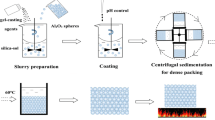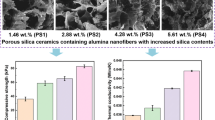Abstract: Colloidal silica (CS) is a promising raw material for refractory castable ceramics. It consists of stable suspensions of synthetic amorphous silica nanoparticles that behave simultaneously as liquid medium and binder for ceramic particles and as a porogenic agent and highly reactive source of silica to promote in-situ reactions. The setting mechanism of CS balances two opposite effects. Adding more CS to a suspension increases the bonding potential for gelling reactions and strengthening; on the other hand, it also introduces more water into the system, enhancing pore content. Such effects can be advantageously employed in the preparation of porous structures from aqueous suspensions and applied as high-temperature thermal insulators. The present study addresses the production of porous structures of in-situ mullite attained from aqueous suspensions of highly porous transition alumina particles bonded with colloidal silica. Different grades of CS and transition aluminas were combined to present suitable workability (flowability and gelling time) and to generate stoichiometric mullite or mullite-alumina porous structures after sintering.










Similar content being viewed by others
References
Salomão, R., Villas-Bôas, M.O.C., Pandolfelli, V.C.: Porous alumina-spinel ceramics for high temperature applications. Ceram. Int. 37 (2011) [4] 1393-1399, doi: 10.1016/j.ceramint.2011.01.012
Hammel, E.C., Ighodaro, O.L.R., Okoli, O.I.: Processing and properties of advanced porous ceramics: An application-based review. Ceram. Int. 40 (2014) [10] 15351-15370, doi: 10.1016/j.ceramint.2014.06.095
Ohji, T., Fukushima, M.: Macro-porous ceramics: processing and properties. Int. Mater. Rev. 57 (2012) [2] 115-131, doi: 10.1179/1743280411Y.0000000006
Souza, A. D. V., Sousa, L. L., Fernandes, L., Cardoso, P. H. L., Salomão, R.: Al2O3-Al(OH)3-based castable porous structures. J. Eur. Ceram. Soc. 35 (2015) [6] 1943-1954, doi: 10.1016/j.jeurceramsoc.2015.01.003
Souza, A.D.V., Salomão, R.: Evaluation of the porogenic behavior of aluminum hydroxide particles of different size distributions in castable high-alumina structure. J. Eur. Ceram. Soc. 36 (2016) [3] 885-897, doi: 10.1016/j.jeurceramsoc.2015.11.019
Deng, Z.Y., Fukasawa, T., Ando, M., Zhang, G. J., Ohji, T.: High-surface-area alumina ceramics fabricated by the decomposition of Al(OH)3. J. Am. Ceram. Soc. 84 (2001) [3] 485-491, doi: 10.1111/j.1151-2916.2001.tb00687.x
Deng, Z. Y., Fukasawa, T., Ando, M., Zhang, G. J., Ohji, T. Microstructure and mechanical properties of porous alumina ceramics fabricated by the decomposition of aluminum hydroxide. J. Am. Ceram. Soc. 84 (2001) [11] 2638-2644, doi : 10.1111/j.1151-2916.2001.tb01065.x
Salomão, R., Brandi, J.: Macrostructures with hierarchical porosity produced from alumina-aluminum hydroxide-chitosan wet-spun fibers. Ceram. Int. 39 (2013) [7] 8227-8235, doi: 10.1016/j.ceramint.2013.04.007
Salomão, R., Souza, A.D.V., Cardoso, P.H.L.: A comparison of Al(OH)3 and Mg(OH)2 as inorganic porogenic agents for alumina. InterCeram 64 (2015) [4] 193-199, doi: 10.1007/BF03401122
Salomão, R., Dias, I.M.M., Fernandes, L.: Porogenesis in the alumina-magnesia-spinel system. Interceram 69 (2020) [3] 46-53 doi: 10.1007/s42411-020-0096-6
Oliveira, I.R. de, Leite, V.M.C., Lima, M.P.V.P., Salomão, R.: Production of porous ceramic material using different sources of alumina and calcia. Matéria 20 (2015) [3] 739-746, doi: 10.1590/S1517-707620150003.0078
Salomão, R., Ferreira, V.L., Costa, L.M.M., Oliveira, I.R. de: Effects of the initial CaO-Al2O3 ratio on the microstructure development and mechanical properties of porous calcium hexaluminate. Ceram. Int. 44 (2018) [2] 2626-2631, doi: 10.1016/j.ceramint.2017.11.010
Sakihama, J., Salomão, R.: Microstructure development in porous calcium hexaluminate and application as a high-temperature thermal insulator: A critical review. Interceram 68 (2019) [1] 58-65, doi: 10.1007/s42411-019-0034-7
Kara, F., Little, J.A.: Sintering behavior of precursor mullite powders and resultant microstructure. J. Eur. Ceram. Soc. 16 (1996) [6] 627-635, doi: 10.1016/0955-2219(95)00179-4
Sousa, L.L., Souza, A.D.V., Fernandes, L., Arantes, V.L., Salomão, R.: Development of densification-resistant castable porous structures from in situ mullite. Ceram. Int. 41 (2015) [8] 9443-9454, doi: 10.1016/j.ceramint.2015.03.328
Sousa, L.L., Salomão, R., Arantes, V.L.: Development and characterization of porous moldable refractory structures of the alumina-mullite-quartz system. Ceram. Int. 43 (2017) [1] 1362-1370, doi: 10.1016/j.ceramint.2016.10.093
Salomão, R., Fernandes, L.: Porous co-continuous mullite structures obtained from sintered aluminum hydroxide and synthetic amorphous silica. J. Eur. Ceram. Soc. 37 (2017) [8] 2849-2856, doi: 10.1016/j.jeurceramsoc.2017.03.017
Fernandes, L., Salomão, R.: Preparation and characterization of mullite-alumina structures formed "in situ" from calcined alumina and different grades of synthetic amorphous silica. Mater. Res. 21 (2018) [3] 21(3): e20170783, doi : 10.1590/1980-5373-MR-2017-0783
Salomão, R., Ismael, M. R., Pandolfelli, V. C.: Hydraulic binders for refractory castables: Mixing, curing and drying. CFI Ceram. Forum Int. 84 (2007) [9] E103-E108
Salomão, R.: Porogenic behavior of water in high-alumina castable structures. Adv. Mater. Sci. Eng. 2018 (2018) 1-10, doi: 10.1155/2018/2876851
Salomão, R., Kawamura, M.A., Souza, A.D.V., Sakihama, J.: Hydratable alumina-bonded suspensions: Evolution of microstructure and physical properties during first heating. Interceram 66 (2017) [7] 28-37, doi: 10.1007/BF03401226
Akhondi, H., Taheri-Nassaj, E., Sarpoolaky, H., Taavoni-Gilan, A.: Gelcasting of alumina nanopowders based on gelation of sodium alginate. Ceram. Int. 35 (2009) [3] 1033-1037, doi: 10.1016/j.ceramint.2008.04.023
Salomão, R., Cardoso, P.H.L., Brandi, J.: Gelcasting porous alumina beads of tailored shape and porosity. Ceram. Int. 40 (2014) [10B] 16595-16601, doi : 10.1016/j.ceramint.2014.08.017
Yang, J., Yu, J., Huang, Y.: Recent developments in gelcasting of ceramics. J. Eur. Ceram. Soc. 31 (2011) [14] 2569-2591, doi: 10.1016/j.jeurceramsoc.2010.12.035
Morissette, S.L., Lewis, J.A.: Chemorheology of aqueous-based alumina-poly(vinyl alcohol) gelcasting suspensions. J. Am. Ceram. Soc. 82 (1999) [3] 521-528, doi: 10.1111/j.1151-2916.1999.tb01796.x
Tseng, W.J., Wu, P.S.: Macroporous gibbsite foams prepared from particle-stabilized emulsions using corn starch and agar as binders. Ceram. Int. 38 (2012) [6] 4461-4465, doi: 10.1016/j.ceramint.2012.02.020
Braulio, M.A.L., Piva, M.F.L., Silva, G.F.L., Pandolfelli, V.C.: In situ spinel expansion design by colloidal alumina suspension addition. J. Am. Ceram. Soc. 92 (2009) [2] 559-562, doi: 10.1111/j.1551-2916.2009.02934.x
Singh, B.P., Menchavez, R., Takai, C., Fuji, M., Takahashi, M.: Stability of dispersions of colloidal alumina particles in aqueous suspensions. J. Colloid Interface Sci. 291 (2005) [1] 181-186, doi: 10.1016/j.jcis.2005.04.091
Zhu, X., Jiang, D., Tan, S., Zhang, Z.: Dispersion properties of alumina powders in silica sol. J. Eur. Ceram. Soc. 21 (2001) [16] 2879-2885, doi: 10.1016/S0955-2219(01)00229-1
Ismael, M.R., Anjos, R.D., Salomão, R., Pandolfelli, V.C.: Colloidal silica as a nanostructured binder for refractory castables. Refract. Appl. News 11 (2006) [4] 16-20
Ismael, M.R., Salomão, R., Pandolfelli, V.C.: Refractory castables based on colloidal silica and hydratable alumina. Am. Cer. Soc. Bull. 86 (2007) [9] 58-62.
Ismael, M.R., Salomão, R., Pandolfelli, V.C.: Optimization of the particle size distribution of colloidal silica containing refractory castables. Interceram Ref. Refractories. Man. 4 (2007) 34-39
Souri, A., Nia, F.K., Sarpoolaky, H.: Improving thermo-mechanical properties of tabular alumina castables via using nano structured colloidal silica. Nanomat. Applic. and Prop. 2 (2011) [2] 254-259
Salomão, R., Souza, A.D.V., Fernandes, L., Arruda, C.C.: Advances in nanotechnology for refractories: When very small meets hot, heavy, and large. Am. Cer. Soc. Bull. 92 (2013) [7] 22-28
Singh, A. K., Sarkar, R.: Nano mullite bonded refractory castable composition for high temperature applications. Ceram. Int. 42 (2016) [11] 12937-12945, doi: 10.1016/j.ceramint.2016.05.066
Iler, R.K.: The chemistry of silica, Wiley, New York (1979), ISBN 978-0-471-02404-0
Fernandes, L., Arruda, C.C., Souza, A.D.V., Salomão, R.: Characterization of synthetic amorphous silica (SAS) used in the ceramics industry. Interceram 63 (2014) 220-224, doi: 10.1007/BF03401063
Quercia, G., Lazaro, A., Geus, J.W., Brouwers, H.J.H.: Characterization of morphology and texture of several amorphous nano-silica particles used in concrete. Cem. Concr. Compos. 44 (2013) 77-92, doi: 10.1016/j.cemconcomp.2013.05.006
Fielitz, P., Borchardt, G., Schneider, H., Schmucker, M., Wiedenbeck, M., Rhede, D.: Self-diffusion of oxygen in mullite. J. Eur. Ceram. Soc. 21 (2001) [14] 2577-2582, doi: 10.1016/S0955-2219(01)00276-X
Mccusker, L.B., Von Dreele, R.B., Cox, D.E., Loue, D., Scardi, P.: Rietveld refinement guidelines. Int. Union Crystallogr. J. Appl. Crystallogr. J. Appl. Cryst. 32 (1999) 36-50, doi: 10.1107/S0021889898009856
Souza, A.D.V., Arruda, C.C., Fernandes, L., Antunes, M.L., Kyiohara, P. P.K., Salomão, R.: Characterization of aluminum hydroxide (Al(OH)3) for use as porogenic agent in castable ceramics. J. Eur. Ceram. Soc. 35 (2015) 803-812, doi: 10.1016/j.jeurceramsoc.2014.09.010
Lange, F.F.: Sinterability of agglomerated powders. J. Am. Ceram. Soc. 67 (1984) [2] 83-89, doi: 10.1557/PROC-24-247
Kimura, T., Matsuda, Y., Oda, M., Yamaguchi, T.: Effects of agglomerates on the sintering of alpha-Al2O3. Ceram. Int. 13 (1987) 27-34. doi: 10.1016/0272-8842(87)90035-6
Aksay, L.A., Pask, J.A.: Stable and metastable equilibria in the system SiO2-Al2O3. J. Am. Ceram. Soc. 58 (1975) [11-12] 507-512. doi: 10.1111/j.1151-2916.1975.tb18770.x
Risbud, S.H., Pask, J.A.: Mullite crystallization from SiO2-Al2O3 melts. J. Am. Ceram. Soc. 61 (1978) [1-2] 63-67. doi: 10.1111/j.1151-2916.1978.tb09232.x
Schneider, H., Schreuer, J., Hildmann, B.: Structure and properties of mullite: A review. J. Eur. Ceram. Soc. 28 (2008) [2] 329-344, doi: 10.1016/j.jeurceramsoc.2007.03.017
Schneider, H., Fischer, R.X., Schreuer, J.: Mullite: crystal structure and related properties. J. Am. Ceram. Soc. 98 (2015) [10] 2948-2967, doi: 10.1111/jace.13817
Farenholtz, W.G., Smith, D.M., Cesarano III, J.: Effect of precursor particle size on the densification and crystallization behavior of mullite. J. Am. Ceram. Soc. 76 (1993) [2] 433-437, doi: 10.1111/j.1151-2916.1993.tb03802.x
Sacks, M.D., Wang, K., Scheiffele, G.W., Bozkurt, N.: Effect of composition on mullitization behavior of α-alumina/silica microcomposite powders. J. Am. Ceram. Soc. 80 (1997) [3] 663-672, doi: 10.1111/j.1151-2916.1997.tb02882.x
Sacks, M.D., Bozkurt, N., Scheiffele, G.W.: Fabrication of mullite and mullite-matrix composites by transient viscous sintering of composite powders. J. Am. Ceram. Soc. 74 (1991) [10] 2428-2437, doi: 10.1111/j.1151-2916.1991.tb06780.x
Acknowledgments
The authors acknowledge Brazilian Research Foundations FAPESP (2010-19274-5; 2017/06738-2; 2018/19773-3), CNPq (305877/2017-8; 408977/2017-5) and CAPES (Financial code 001), for supporting this research, and Alcoa Alumínio (Brazil) and Nouryon South America (Brazil), for supplying the samples of aluminium hydroxide and colloidal silica, respectively. They are indebted to the Electron Microscopy Laboratory of Advanced Materials Research Support Center, EESC/IFSC for the SEM images. The authors also declare that, to the best of their knowledge, no competing interests (financial or personal) affected the results reported in this paper and that they cited all funding and supporting sources.
Author information
Authors and Affiliations
Rights and permissions
About this article
Cite this article
de Mendonça Spera, N., Fernandes, L., Sakihama, J. et al. Designing Colloidal Silica-Bonded Porous Structures of In-situ Mullite for Thermal Insulation. Interceram. - Int. Ceram. Rev. 69, 54–63 (2020). https://doi.org/10.1007/s42411-020-0120-x
Published:
Issue Date:
DOI: https://doi.org/10.1007/s42411-020-0120-x




